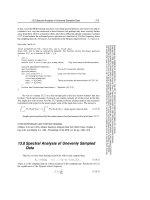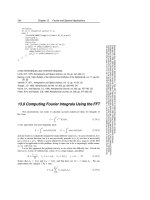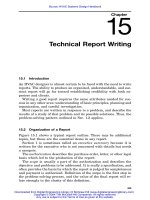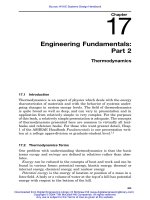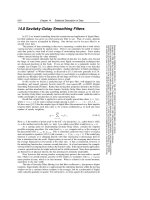Tài liệu Fourier and Spectral Applications part 5 pptx
Bạn đang xem bản rút gọn của tài liệu. Xem và tải ngay bản đầy đủ của tài liệu tại đây (179.58 KB, 10 trang )
13.4 Power Spectrum Estimation Using the FFT
549
Sample page from NUMERICAL RECIPES IN C: THE ART OF SCIENTIFIC COMPUTING (ISBN 0-521-43108-5)
Copyright (C) 1988-1992 by Cambridge University Press.Programs Copyright (C) 1988-1992 by Numerical Recipes Software.
Permission is granted for internet users to make one paper copy for their own personal use. Further reproduction, or any copying of machine-
readable files (including this one) to any servercomputer, is strictly prohibited. To order Numerical Recipes books,diskettes, or CDROMs
visit website or call 1-800-872-7423 (North America only),or send email to (outside North America).
S
2
(deduced)
N
2
(extrapolated)
C
2
(measured)
log scale
f
Figure 13.3.1. Optimal (Wiener) filtering. The power spectrum of signal plus noise shows a signal peak
added to a noise tail. The tail is extrapolated back into the signal region as a “noise model.” Subtracting
gives the “signal model.” The models need not be accurate for the method to be useful. A simple
algebraic combination of the models gives the optimal filter (see text).
new signal which you could improve even further with the same filtering technique.
Don’t waste your time on this line of thought. The scheme converges to a signal of
S(f)=0. Converging iterative methods do exist; this just isn’t one of them.
You can use the routine four1 (§12.2) or realft (§12.3) to FFT your data
when you are constructing an optimal filter. To apply the filter to your data, you
can use the methods described in §13.1. The specific routine convlv is not needed
for optimal filtering, since your filter is constructed in the frequency domain to
begin with. If you are also deconvolving your data with a known response function,
however, you can modify convlv to multiply by your optimal filter just before it
takes the inverse Fourier transform.
CITED REFERENCES AND FURTHER READING:
Rabiner, L.R., and Gold, B. 1975,
Theory and Application of Digital Signal Processing
(Englewood
Cliffs, NJ: Prentice-Hall).
Nussbaumer, H.J. 1982,
Fast Fourier Transform and Convolution Algorithms
(New York: Springer-
Verlag).
Elliott, D.F., and Rao, K.R. 1982,
Fast Transforms: Algorithms, Analyses, Applications
(New
York: Academic Press).
13.4 Power Spectrum Estimation Using the FFT
Intheprevioussectionwe“informally”estimated thepowerspectral densityofa
functionc(t) bytaking themodulus-squaredof the discrete Fouriertransformof some
550
Chapter 13. Fourier and Spectral Applications
Sample page from NUMERICAL RECIPES IN C: THE ART OF SCIENTIFIC COMPUTING (ISBN 0-521-43108-5)
Copyright (C) 1988-1992 by Cambridge University Press.Programs Copyright (C) 1988-1992 by Numerical Recipes Software.
Permission is granted for internet users to make one paper copy for their own personal use. Further reproduction, or any copying of machine-
readable files (including this one) to any servercomputer, is strictly prohibited. To order Numerical Recipes books,diskettes, or CDROMs
visit website or call 1-800-872-7423 (North America only),or send email to (outside North America).
finite, sampled stretch of it. In this section we’ll do roughly the same thing, but with
considerably greater attention to details. Our attention will uncover some surprises.
The first detail is power spectrum (also called a power spectral density or
PSD) normalization. In general there is some relation of proportionality between a
measure of the squared amplitude of the function and a measure of the amplitude
of the PSD. Unfortunately there are several different conventions for describing
the normalization in each domain, and many opportunities for getting wrong the
relationship between the two domains. Suppose that our function c(t) is sampled at
N points to produce values c
0
c
N−1
, and that these points span a range of time
T ,thatisT =(N−1)∆,where∆is the sampling interval. Then here are several
different descriptions of the total power:
N−1
j=0
|c
j
|
2
≡ “sum squared amplitude” (13.4.1)
1
T
T
0
|c(t)|
2
dt ≈
1
N
N−1
j=0
|c
j
|
2
≡ “mean squared amplitude” (13.4.2)
T
0
|c(t)|
2
dt ≈ ∆
N−1
j=0
|c
j
|
2
≡ “time-integral squared amplitude” (13.4.3)
PSD estimators, as we shall see, have an even greater variety. In this section,
we consider a class of them that give estimates at discrete values of frequency f
i
,
where i will range over integer values. In the next section, we will learn about
a different class of estimators that produce estimates that are continuous functions
of frequency f. Even if it is agreed always to relate the PSD normalization to a
particular description of the function normalization (e.g., 13.4.2), there are at least
the following possibilities: The PSD is
• defined for discrete positive, zero, and negative frequencies, and its sum
over these is the function mean squared amplitude
• defined for zero and discrete positive frequencies only, and its sum over
these is the function mean squared amplitude
• defined in the Nyquist interval from −f
c
to f
c
, and its integral over this
range is the function mean squared amplitude
• defined from 0 to f
c
, and its integral over this range is the function mean
squared amplitude
It never makes sense to integrate the PSD of a sampled function outside of the
Nyquist interval −f
c
and f
c
since, according to the sampling theorem, power there
will have been aliased into the Nyquist interval.
It is hopeless to define enough notation to distinguish all possible combinations
of normalizations. In what follows, we use the notation P (f) to mean any of the
above PSDs, stating in each instance how the particular P (f) is normalized. Beware
the inconsistent notation in the literature.
The method of power spectrum estimation used in the previous section is a
simple version of an estimator called, historically, the periodogram.Ifwetakean
N-point sample of the function c(t) at equal intervals and use the FFT to compute
13.4 Power Spectrum Estimation Using the FFT
551
Sample page from NUMERICAL RECIPES IN C: THE ART OF SCIENTIFIC COMPUTING (ISBN 0-521-43108-5)
Copyright (C) 1988-1992 by Cambridge University Press.Programs Copyright (C) 1988-1992 by Numerical Recipes Software.
Permission is granted for internet users to make one paper copy for their own personal use. Further reproduction, or any copying of machine-
readable files (including this one) to any servercomputer, is strictly prohibited. To order Numerical Recipes books,diskettes, or CDROMs
visit website or call 1-800-872-7423 (North America only),or send email to (outside North America).
its discrete Fourier transform
C
k
=
N−1
j=0
c
j
e
2πijk/N
k =0, ,N −1(13.4.4)
then the periodogram estimate of the power spectrum is defined at N/2+1
frequencies as
P (0) = P (f
0
)=
1
N
2
|C
0
|
2
P(f
k
)=
1
N
2
|C
k
|
2
+|C
N−k
|
2
k=1,2, ,
N
2
−1
P(f
c
)=P(f
N/2
)=
1
N
2
C
N/2
2
(13.4.5)
where f
k
is defined only for the zero and positive frequencies
f
k
≡
k
N∆
=2f
c
k
N
k=0,1, ,
N
2
(13.4.6)
By Parseval’s theorem, equation(12.1.10),we see immediatelythat equation(13.4.5)
is normalized so that the sum of the N/2+1values of P is equal to the mean
squared amplitude of the function c
j
.
We must now ask this question. In what sense is the periodogram estimate
(13.4.5) a “true” estimator of the power spectrum of the underlying function c(t)?
You can find the answer treated in considerable detail in the literature cited (see,
e.g.,
[1]
for an introduction). Here is a summary.
First, is the expectation value of the periodogram estimate equal to the power
spectrum, i.e., is the estimator correct on average? Well, yes and no. We wouldn’t
really expect one of the P (f
k
)’s to equal the continuousP(f) at exactly f
k
,sincef
k
is supposed to be representative of a whole frequency “bin” extending from halfway
from the preceding discrete frequency to halfway to the next one. We should be
expecting the P (f
k
) to be some kind of average of P (f) over a narrow window
function centered on its f
k
. For the periodogram estimate (13.4.6) that window
function, as a function of s the frequency offset in bins,is
W(s)=
1
N
2
sin(πs)
sin(πs/N)
2
(13.4.7)
Notice that W(s) has oscillatory lobes but, apart from these, falls off only about as
W (s) ≈ (πs)
−2
. This is not a very rapid fall-off, and it results in significant leakage
(thatis the technical term)fromone frequencytoanotherin theperiodogramestimate.
Notice alsothat W (s) happens to bezero for s equal to a nonzero integer. This means
that if the function c(t) is a pure sine wave of frequency exactly equal to one of the
f
k
’s, then there will be no leakage to adjacent f
k
’s. But this is not the characteristic
case! If the frequency is, say, one-third of the way between two adjacent f
k
’s, then
the leakage will extend well beyond those two adjacent bins. The solution to the
problem of leakage is called data windowing, and we will discuss it below.
552
Chapter 13. Fourier and Spectral Applications
Sample page from NUMERICAL RECIPES IN C: THE ART OF SCIENTIFIC COMPUTING (ISBN 0-521-43108-5)
Copyright (C) 1988-1992 by Cambridge University Press.Programs Copyright (C) 1988-1992 by Numerical Recipes Software.
Permission is granted for internet users to make one paper copy for their own personal use. Further reproduction, or any copying of machine-
readable files (including this one) to any servercomputer, is strictly prohibited. To order Numerical Recipes books,diskettes, or CDROMs
visit website or call 1-800-872-7423 (North America only),or send email to (outside North America).
Turn now to another question about the periodogram estimate. What is the
variance of that estimate as N goes to infinity? In other words, as we take more
sampled points from the original function (either sampling a longer stretch of data at
the same sampling rate, or else by resampling the same stretch of data with a faster
sampling rate), then how much more accurate do the estimates P
k
become? The
unpleasant answer is that the periodogram estimates do not become more accurate
at all! In fact, the variance of the periodogram estimate at a frequency f
k
is always
equal to the square of its expectation value at that frequency. In other words, the
standard deviation is always 100 percent of the value, independent of N ! How can
this be? Where did all the information go as we added points? It all went into
producing estimates at a greater number of discrete frequencies f
k
.Ifwesamplea
longer run of data using the same sampling rate, then the Nyquist critical frequency
f
c
is unchanged, but we now have finer frequency resolution (more f
k
’s) within the
Nyquistfrequency interval; alternatively, if we sample the same length of data witha
finer sampling interval, then our frequency resolution is unchanged, but the Nyquist
rangenow extendsupto a higher frequency. In neithercase do the additionalsamples
reduce the variance of any one particular frequency’s estimated PSD.
You don’t have to live with PSD estimates with 100percent standard deviations,
however. You simply have to know some techniques for reducing the variance of
the estimates. Here are two techniques that are very nearly identical mathematically,
though different in implementation. The first is to compute a periodogram estimate
with finer discrete frequency spacing than you really need, and then to sum the
periodogram estimates at K consecutive discrete frequencies to get one “smoother”
estimate at the mid frequency of those K. The variance of that summed estimate
will be smaller than the estimate itself by a factor of exactly 1/K, i.e., the standard
deviation will be smaller than 100 percent by a factor 1/
√
K. Thus, to estimate the
power spectrum at M +1discrete frequencies between 0 and f
c
inclusive, you begin
by taking the FFT of 2MK points (which number had better be an integer power of
two!). You then take the modulus square of the resulting coefficients, add positive
and negative frequency pairs, and divide by (2MK)
2
, all according to equation
(13.4.5) with N =2MK. Finally, you “bin” the results intosummed (not averaged)
groups of K. This procedure is very easy to program, so we will not bother to give
a routine for it. The reason that you sum, rather than average, K consecutive points
is so that your final PSD estimate will preserve the normalization property that the
sum of its M +1values equals the mean square value of the function.
A second technique for estimating the PSD at M +1discrete frequencies in
the range 0 to f
c
is to partition the original sampled data into K segments each of
2M consecutive sampled points. Each segment is separately FFT’d to produce a
periodogram estimate (equation 13.4.5 with N ≡ 2M). Finally, the K periodogram
estimates are averaged at each frequency. It is this final averaging that reduces the
variance of the estimate by a factor K (standard deviation by
√
K). This second
techniqueiscomputationallymoreefficient than thefirst techniqueabove bya modest
factor, since it is logarithmically more efficient to take many shorter FFTs than one
longer one. The principal advantage of the second technique, however, is that only
2M data points are manipulated at a single time, not 2KM as in the first technique.
This means that the second technique is the natural choice for processing long runs
of data, as from a magnetic tape or other data record. We will give a routine later
for implementing this second technique, but we need first to return to the matters of
13.4 Power Spectrum Estimation Using the FFT
553
Sample page from NUMERICAL RECIPES IN C: THE ART OF SCIENTIFIC COMPUTING (ISBN 0-521-43108-5)
Copyright (C) 1988-1992 by Cambridge University Press.Programs Copyright (C) 1988-1992 by Numerical Recipes Software.
Permission is granted for internet users to make one paper copy for their own personal use. Further reproduction, or any copying of machine-
readable files (including this one) to any servercomputer, is strictly prohibited. To order Numerical Recipes books,diskettes, or CDROMs
visit website or call 1-800-872-7423 (North America only),or send email to (outside North America).
leakage and data windowing which were brought up after equation (13.4.7) above.
Data Windowing
The purpose of data windowing is to modify equation (13.4.7), which expresses
the relation between the spectral estimate P
k
at a discrete frequency and the actual
underlyingcontinuous spectrum P(f) at nearby frequencies. In general, the spectral
power in one “bin” k contains leakage from frequency components that are actually
s bins away, where s is the independent variable in equation (13.4.7). There is, as
we pointed out, quite substantial leakage even from moderately large values of s.
When we select a run of N sampled pointsfor periodogram spectral estimation,
we are in effect multiplying an infinite run of sampled data c
j
by a window function
in time, onethatis zero except duringthetotalsamplingtimeN∆, and is unityduring
that time. In other words, the data are windowed by a square window function. By
the convolution theorem (12.0.9; but interchanging the roles of f and t), the Fourier
transform of the product of the data with this square window function is equal to the
convolutionof the data’s Fourier transform with the window’sFourier transform. In
fact, we determined equation (13.4.7) as nothingmore than the square of the discrete
Fourier transform of the unity window function.
W (s)=
1
N
2
sin(πs)
sin(πs/N)
2
=
1
N
2
N−1
k=0
e
2πisk/N
2
(13.4.8)
The reason for the leakage at large values of s, is that the square window function
turns on and off so rapidly. Its Fourier transform has substantial components
at high frequencies. To remedy this situation, we can multiply the input data
c
j
,j=0, ,N−1 by a window function w
j
that changes more gradually from
zero to a maximum and then back to zero as j ranges from 0 to N. In this case, the
equations for the periodogram estimator (13.4.4–13.4.5) become
D
k
≡
N−1
j=0
c
j
w
j
e
2πijk/N
k =0, ,N−1(13.4.9)
P (0) = P (f
0
)=
1
W
ss
|D
0
|
2
P (f
k
)=
1
W
ss
|D
k
|
2
+ |D
N−k
|
2
k =1,2, ,
N
2
−1
P(f
c
)=P(f
N/2
)=
1
W
ss
D
N/2
2
(13.4.10)
where W
ss
stands for “window squared and summed,”
W
ss
≡ N
N−1
j=0
w
2
j
(13.4.11)
554
Chapter 13. Fourier and Spectral Applications
Sample page from NUMERICAL RECIPES IN C: THE ART OF SCIENTIFIC COMPUTING (ISBN 0-521-43108-5)
Copyright (C) 1988-1992 by Cambridge University Press.Programs Copyright (C) 1988-1992 by Numerical Recipes Software.
Permission is granted for internet users to make one paper copy for their own personal use. Further reproduction, or any copying of machine-
readable files (including this one) to any servercomputer, is strictly prohibited. To order Numerical Recipes books,diskettes, or CDROMs
visit website or call 1-800-872-7423 (North America only),or send email to (outside North America).
and f
k
is given by (13.4.6). The more general form of (13.4.7) can now be written
in terms of the window function w
j
as
W (s)=
1
W
ss
N−1
k=0
e
2πisk/N
w
k
2
≈
1
W
ss
N/2
−N/2
cos(2πsk/N)w(k −N/2) dk
2
(13.4.12)
Here the approximate equality is useful for practical estimates, and holds for any
window that is left-right symmetric (the usual case), and for s N (the case of
interest for estimatingleakageinto nearby bins). Thecontinuousfunctionw(k−N/2)
in the integral is meant to be some smooth function that passes throughthe points w
k
.
There isalotofperhapsunnecessary loreabout choiceofa windowfunction,and
practically every function that rises from zero to a peak and then falls again has been
named after someone. A few of the more common (also shown in Figure 13.4.1) are:
w
j
=1−
j−
1
2
N
1
2
N
≡“Bartlett window” (13.4.13)
(The “Parzen window” is very similar to this.)
w
j
=
1
2
1 −cos
2πj
N
≡ “Hann window” (13.4.14)
(The “Hamming window” is similar but does not go exactly to zero at the ends.)
w
j
=1−
j−
1
2
N
1
2
N
2
≡“Welch window” (13.4.15)
We are inclined to followWelch in recommending that you use either (13.4.13)
or (13.4.15) in practical work. However, at the level of this book, there is
effectively no difference between any of these (or similar) window functions. Their
difference lies in subtle trade-offs among the various figures of merit that can be
used to describe the narrowness or peakedness of the spectral leakage functions
computed by (13.4.12). These figures of merit have such names as: highest sidelobe
level (dB), sidelobe fall-off (dB per octave), equivalent noise bandwidth(bins), 3-dB
bandwidth (bins), scallop loss (dB), worst case process loss (dB). Roughly speaking,
the principal trade-off is between making the central peak as narrow as possible
versus making the tails of the distribution fall off as rapidly as possible. For
details, see (e.g.)
[2]
. Figure 13.4.2 plots the leakage amplitudes for several windows
already discussed.
There is particularly a lore about window functions that rise smoothly from
zero to unity in the first small fraction (say 10 percent) of the data, then stay at
unity until the last small fraction (again say 10 percent) of the data, during which
the window function falls smoothly back to zero. These windows will squeeze a
little bit of extra narrowness out of the main lobe of the leakage function (never as
13.4 Power Spectrum Estimation Using the FFT
555
Sample page from NUMERICAL RECIPES IN C: THE ART OF SCIENTIFIC COMPUTING (ISBN 0-521-43108-5)
Copyright (C) 1988-1992 by Cambridge University Press.Programs Copyright (C) 1988-1992 by Numerical Recipes Software.
Permission is granted for internet users to make one paper copy for their own personal use. Further reproduction, or any copying of machine-
readable files (including this one) to any servercomputer, is strictly prohibited. To order Numerical Recipes books,diskettes, or CDROMs
visit website or call 1-800-872-7423 (North America only),or send email to (outside North America).
amplitude
0
.2
.4
.6
.8
1
0 50 100 150 200 250
bin number
Bartlett window
Welch window
square window
Hann window
Figure 13.4.1. Window functions commonly used in FFT power spectral estimation. The data segment,
here of length 256, is multiplied (bin by bin) by the window function before the FFT is computed. The
square window, which is equivalent to no windowing, is least recommended. The Welch and Bartlett
windows are good choices.
much as a factor of two, however), but trade this off by widening the leakage tail
by a significant factor (e.g., the reciprocal of 10 percent, a factor of ten). If we
distinguish between the width of a window (number of samples for which it is at
its maximum value) and its rise/fall time (number of samples during which it rises
and falls); and if we distinguish between the FWHM (full width to half maximum
value) of the leakage function’s main lobe and the leakage width (full width that
contains half of the spectral power that is not contained in the main lobe); then
these quantities are related roughly by
(FWHM in bins) ≈
N
(window width)
(13.4.16)
(leakage width in bins) ≈
N
(window rise/fall time)
(13.4.17)
For the windows given above in (13.4.13)–(13.4.15), the effective window
widths and the effective window rise/fall times are both of order
1
2
N. Generally
speaking, we feel that the advantages of windows whose rise and fall times are
only small fractions of the data length are minor or nonexistent, and we avoid using
them. One sometimes hears it said that flat-topped windows “throw away less of
the data,” but we will now show you a better way of dealing with that problem by
use of overlapping data segments.
Let us now suppose that we have chosen a window function, and that we are
ready to segment the data into K segments of N =2Mpoints. Each segment will
be FFT’d, and the resulting K periodograms will be averaged together to obtain a
556
Chapter 13. Fourier and Spectral Applications
Sample page from NUMERICAL RECIPES IN C: THE ART OF SCIENTIFIC COMPUTING (ISBN 0-521-43108-5)
Copyright (C) 1988-1992 by Cambridge University Press.Programs Copyright (C) 1988-1992 by Numerical Recipes Software.
Permission is granted for internet users to make one paper copy for their own personal use. Further reproduction, or any copying of machine-
readable files (including this one) to any servercomputer, is strictly prohibited. To order Numerical Recipes books,diskettes, or CDROMs
visit website or call 1-800-872-7423 (North America only),or send email to (outside North America).
amplitude of leakage
0
.2
.4
.6
.8
1
−8 − 6 − 4 −20 2 4 6 8
Hann
Bartlett
Welch
offset in units of frequency bins
square
Figure 13.4.2. Leakage functions for the window functions of Figure 13.4.1. A signal whose
frequency is actually located at zero offset “leaks” into neighboring bins with the amplitude shown. The
purpose of windowing is to reduce the leakage at large offsets, where square (no) windowing has large
sidelobes. Offset can have a fractional value, since the actual signal frequency can be located between
two frequency bins of the FFT.
PSD estimate at M +1frequency values from 0 to f
c
. We must now distinguish
between two possible situations. We might want to obtain the smallest variance
from a fixed amount of computation, without regard to the number of data points
used. This will generally be the goal when the data are being gathered in real time,
with the data-reduction being computer-limited. Alternatively, we might want to
obtain the smallest variance from a fixed number of available sampled data points.
This will generally be the goal in cases where the data are already recorded and
we are analyzing it after the fact.
In the first situation (smallest spectral variance per computer operation), it is
best to segment the data without any overlapping. The first 2M datapointsconstitute
segment number 1; the next 2M data points constitute segment number 2; and so
on, up to segment number K, for a total of 2KM sampled points. The variance in
this case, relative to a single segment, is reduced by a factor K.
In the second situation (smallest spectral variance per data point), it turns out
to be optimal, or very nearly optimal, to overlap the segments by one half of their
length. The first and second sets of M points are segment number 1; the second
and third sets of M points are segment number 2; and so on, up to segment number
K, which is made of the Kth and K +1st sets of M points. The total number of
sampled points is therefore(K +1)M, just overhalf as many as with nonoverlapping
segments. The reduction in the variance is not a full factor of K, since the segments
are not statistically independent. It can be shown that the variance is instead reduced
by a factor of about 9K/11 (see the paper by Welch in
[3]
). This is, however,
13.4 Power Spectrum Estimation Using the FFT
557
Sample page from NUMERICAL RECIPES IN C: THE ART OF SCIENTIFIC COMPUTING (ISBN 0-521-43108-5)
Copyright (C) 1988-1992 by Cambridge University Press.Programs Copyright (C) 1988-1992 by Numerical Recipes Software.
Permission is granted for internet users to make one paper copy for their own personal use. Further reproduction, or any copying of machine-
readable files (including this one) to any servercomputer, is strictly prohibited. To order Numerical Recipes books,diskettes, or CDROMs
visit website or call 1-800-872-7423 (North America only),or send email to (outside North America).
significantly better than the reduction of about K/2 that would have resulted if the
same number of data points were segmented without overlapping.
We can now codify these ideas into a routine for spectral estimation. While
we generally avoid input/output coding, we make an exception here to show how
data are read sequentially in one pass through a data file (referenced through the
parameter FILE *fp). Only a small fractionof the data is in memory at any one time.
Note that spctrm returns the power at M , not M +1, frequencies, omitting the
component P (f
c
) at the Nyquist frequency. It would also be straightforward to
include that component.
#include <math.h>
#include <stdio.h>
#include "nrutil.h"
#define WINDOW(j,a,b) (1.0-fabs((((j)-1)-(a))*(b))) /* Bartlett */
/* #define WINDOW(j,a,b) 1.0 */ /* Square */
/* #define WINDOW(j,a,b) (1.0-SQR((((j)-1)-(a))*(b))) */ /* Welch */
void spctrm(FILE *fp, float p[], int m, int k, int ovrlap)
Reads data from input stream specified by file pointer
fp and returns as p[j] the data’s power
(mean square amplitude) at frequency
(j-1)/(2*m) cycles per gridpoint, for j=1,2, ,m,
based on
(2*k+1)*m data points (if ovrlap is set true (1)) or 4*k*m data points (if ovrlap
is set false (0)). The number of segments of the data is 2*k in both cases: The routine calls
four1 k times, each call with 2 partitions each of 2*m real data points.
{
void four1(float data[], unsigned long nn, int isign);
int mm,m44,m43,m4,kk,joffn,joff,j2,j;
float w,facp,facm,*w1,*w2,sumw=0.0,den=0.0;
mm=m+m; Useful factors.
m43=(m4=mm+mm)+3;
m44=m43+1;
w1=vector(1,m4);
w2=vector(1,m);
facm=m;
facp=1.0/m;
for (j=1;j<=mm;j++) sumw += SQR(WINDOW(j,facm,facp));
Accumulate the squared sum of the weights.
for (j=1;j<=m;j++) p[j]=0.0; Initialize the spectrum to zero.
if (ovrlap) Initialize the “save” half-buffer.
for (j=1;j<=m;j++) fscanf(fp,"%f",&w2[j]);
for (kk=1;kk<=k;kk++) {
Loop over data set segments in groups of two.
for (joff = -1;joff<=0;joff++) { Get two complete segmentsinto workspace.
if (ovrlap) {
for (j=1;j<=m;j++) w1[joff+j+j]=w2[j];
for (j=1;j<=m;j++) fscanf(fp,"%f",&w2[j]);
joffn=joff+mm;
for (j=1;j<=m;j++) w1[joffn+j+j]=w2[j];
} else {
for (j=joff+2;j<=m4;j+=2)
fscanf(fp,"%f",&w1[j]);
}
}
for (j=1;j<=mm;j++) { Apply the window to the data.
j2=j+j;
w=WINDOW(j,facm,facp);
w1[j2] *= w;
w1[j2-1] *= w;
}
four1(w1,mm,1); Fourier transform the windowed data.
p[1] += (SQR(w1[1])+SQR(w1[2])); Sum results into previous segments.
558
Chapter 13. Fourier and Spectral Applications
Sample page from NUMERICAL RECIPES IN C: THE ART OF SCIENTIFIC COMPUTING (ISBN 0-521-43108-5)
Copyright (C) 1988-1992 by Cambridge University Press.Programs Copyright (C) 1988-1992 by Numerical Recipes Software.
Permission is granted for internet users to make one paper copy for their own personal use. Further reproduction, or any copying of machine-
readable files (including this one) to any servercomputer, is strictly prohibited. To order Numerical Recipes books,diskettes, or CDROMs
visit website or call 1-800-872-7423 (North America only),or send email to (outside North America).
for (j=2;j<=m;j++) {
j2=j+j;
p[j] += (SQR(w1[j2])+SQR(w1[j2-1])
+SQR(w1[m44-j2])+SQR(w1[m43-j2]));
}
den += sumw;
}
den *= m4; Correct normalization.
for (j=1;j<=m;j++) p[j] /= den; Normalize the output.
free_vector(w2,1,m);
free_vector(w1,1,m4);
}
CITED REFERENCES AND FURTHER READING:
Oppenheim, A.V., and Schafer, R.W. 1989,
Discrete-Time Signal Processing
(Englewood Cliffs,
NJ: Prentice-Hall). [1]
Harris, F.J. 1978,
Proceedings of the IEEE
, vol. 66, pp. 51–83. [2]
Childers, D.G. (ed.) 1978,
Modern Spectrum Analysis
(New York: IEEE Press), paper by P.D.
Welch. [3]
Champeney, D.C. 1973,
Fourier Transforms and Their Physical Applications
(New York: Aca-
demic Press).
Elliott, D.F., and Rao, K.R. 1982,
Fast Transforms: Algorithms, Analyses, Applications
(New
York: Academic Press).
Bloomfield, P. 1976,
Fourier Analysis of Time Series – An Introduction
(New York: Wiley).
Rabiner, L.R., and Gold, B. 1975,
Theory and Application of Digital Signal Processing
(Englewood
Cliffs, NJ: Prentice-Hall).
13.5 Digital Filtering in the Time Domain
Suppose that you have a signal that you want to filter digitally. For example, perhaps
you want to apply high-passor low-pass filtering, to eliminate noise at low or high frequencies
respectively; or perhaps the interesting part of your signal lies only in a certain frequency
band, so that you need a bandpass filter. Or, if your measurements are contaminated by 60
Hz power-line interference, you may need a notch filter to remove only a narrow band around
that frequency. This section speaks particularly about the case in which you have chosen to
do such filtering in the time domain.
Before continuing, we hope you will reconsider this choice. Remember how convenient
it is to filter in the Fourier domain. You just take your whole data record, FFT it, multiply
the FFT output by a filter function H(f), and then do an inverse FFT to get back a filtered
data set in time domain. Here is some additional background on the Fourier technique that
you will want to take into account.
• Remember that you must define your filter function H(f) for both positive and
negative frequencies, and that the magnitude of the frequency extremes is always
the Nyquist frequency 1/(2∆),where∆is the sampling interval. The magnitude
of the smallest nonzero frequencies in the FFT is ±1/(N∆),whereNis the
number of (complex) points in the FFT. The positive and negative frequencies to
which this filter are applied are arranged in wrap-around order.
• If the measureddata are real, and you want the filtered output also to be real, then
your arbitrary filter function should obey H(−f)=H(f)*. You can arrange this
most easily by picking an H that is real and even in f.
